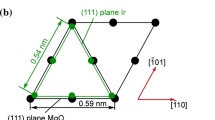Abstract
We have grown single-crystal thin films of Ti2GeC and Ti3GeC2 and a new phase Ti4GeC3, as well as two new intergrown MAX-structures, Ti5Ge2C3 and Ti7Ge2C5. Epitaxial films were grown on Al2O3(0001) substrates at 1000 °C using direct current magnetron sputtering. X-ray diffraction shows that Ti–Ge–C MAX-phases require higher deposition temperatures in a narrower window than their Ti–Si–C correspondences do, while there are similarities in phase distribution. Nanoindentation reveals a Young’s modulus of 300 GPa, lower than that of Ti3SiC2. Four-point probe measurements yield resistivity values of 50–200 µΩcm. The lowest value is obtained for phase-pure Ti3GeC2(0001) films.
Similar content being viewed by others
References
M.W. Barsoum: The Mn+1AXn phases: A new class of solids. Prog. Solid State Chem. 28, 201 (2000).
H. Nowotny: Strukturchemie einiger Verbindungen der Übergangsmetalle mit den Elementen C, Si, Ge, Sn. Prog. Solid State Chem. 2, 27 (1970).
W. Jeitschko and H. Nowotny: Die Kristallstruktur von Ti3SiC2- ein neuer Komplexcarbid-Typ. Monatsh. Chem. 98, 329 (1967).
Y. Zhou, Z. Sun, X. Wang, and S. Chen: Ab initio geometry optimization and ground-state properties of layered ternary carbides Ti3MC2 (M = Al, Si and Ge). J. Phys. Condens. Matter 13, 10001 (2001).
J-P. Palmquist, U. Jansson, T. Seppänen, P.O.Å. Persson, J. Birch, L. Hultman, and P. Isberg: Magnetron sputtered epitaxial singlephase Ti3SiC2 thin films. Appl. Phys. Lett. 81, 835 (2002).
T. Seppänen, J-P. Palmquist, P.O.Å. Persson, J. Emmerlich, J.M. Molina-Aldareguia, J. Birch, U. Jansson, P. Isberg, and L. Hultman: Structural characterization of epitaxial Ti3SiC2 films, in SCANDEM Conference Proceedings, edited by Jaakko Kera¨nen and Katri Sillanpää, Tampere, Finland (2002), pp. 142–143.
J-P. Palmquist, S. Li, P.O.Å. Persson, J. Emmerlich, O. Wilhelmsson, H. Högberg, M. Katsnelsson, B. Johansson, R. Ahuja, O. Eriksson, L. Hultman, and U. Jansson: New MAX phases in the Ti–Si–C system studied by thin film syntheis and ab initio calculations. Phys. Rev. B 70, 165401 (2004).
J. Emmerlich, J-P. Palmquist, H. Högberg, J.M. Molina-Aldareguia, Zs. Czigány, Sz. Sasvári, P.O.Å. Persson, U. Jansson, and L. Hultman: Growth of Ti3SiC2 thin films by elemental target magnetron sputtering. J. Appl. Phys. 96, 4817 (2004).
J.M. Molina-Aldareguia, J. Emmerlich, J-P. Palmquist, U. Jansson, and L. Hultman: Kink formation around indents in laminated Ti3SiC2 thin films studied in the nanoscale. Scripta Mater. 49, 155 (2003).
H. Wolfsgruber, H. Nowotny, and F. Benesovsky: Die Kristallstruktur von Ti3GeC2. Monatsh. Chem. 98, 2403 (1967).
J.S. Kephart and A.H. Carim: Ternary compounds and phase equilibria in Ti–Ge–C and Ti–Ge–B. J. Electrochem. Soc. 145, 3253 (1997).
J.C. Viala, N. Peillon, F. Bosselet, and J. Bouix: Phase equilibria at 1000 °C in the Al–C–Si–Ti quaternary system: An experimental approach. Mater. Sci. Eng. A 229, 95 (1997).
E. Wu, E.H. Kisi, S.J. Kennedy, and A.J. Studer: In situ neutron powder diffraction study of Ti3SiC2 synthesis. J. Am. Ceram. Soc. 84, 2281 (2001).
D.P. Riley, E.H. Kisi, T.C. Hansen, and A.W. Hewat: Selfpropagating high temperature synthesis of Ti3SiC2: 1. Ultra-high speed neutron diffraction study of the reaction mechanism. J. Am. Ceram. Soc. 85, 2417 (2002).
Author information
Authors and Affiliations
Rights and permissions
About this article
Cite this article
Högberg, H., Eklund, P., Emmerlich, J. et al. Epitaxial Ti2GeC, Ti3GeC2, and Ti4GeC3 MAX-phase thin films grown by magnetron sputtering. Journal of Materials Research 20, 779–782 (2005). https://doi.org/10.1557/JMR.2005.0105
Received:
Accepted:
Published:
Issue Date:
DOI: https://doi.org/10.1557/JMR.2005.0105




